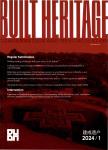Analyses and architectural typology of preserved traditional mosques in the old city of Herat in Afghanistan:the case of Quzzat Quarter
作者机构:Faculty of Engineering and ScienceUniversity of the Ryukyus1 Aza-SenbaruNishihara-choNakagami-gunOkinawa 903-0213Japan
出 版 物:《Built Heritage》 (建成遗产(英文))
年 卷 期:2022年第6卷第4期
页 面:51-64页
核心收录:
学科分类:0601[历史学-考古学] 06[历史学] 060107[历史学-文化遗产与博物馆]
基 金:funded by the University of the Ryukyus.
主 题:Architectural analyses Analogy Period of development Preserved traditional mosques Built heritage conservation Herat Old City Afghanistan
摘 要:The study aims to analyse the architectural typology and determine the period of construction for the preserved traditional mosques of the Quzzat Quarter in the Old City of Herat(known as the Pearl of Khorasan).Twenty-nine mosques are located in the area,three of which are modern and 26 are traditional.Twelve out of the 26 traditional mosques still exist and have preserved their traditional landscape.Using analogy to analyse water cisterns and mosques,we determine when each mosque was developed and establish the period of development for each structure.Further analyses are carried out on the edifces’architectural details.Architectural analyses and mosque typologies suggest that fve buildings were built before the Timurid dynasty;two were built during the Timurid dynasty(1370−1507 CE);and one was built after the Timurid dynasty.Two mosques incorporating elements from diferent periods are counted as exceptions,and the remaining two are considered to have been built during transitional periods.



